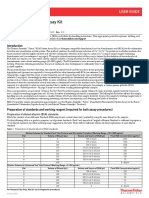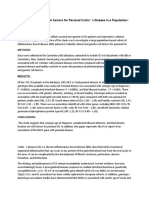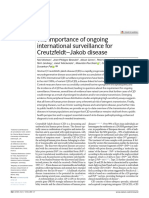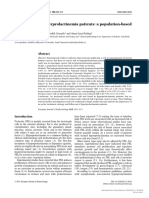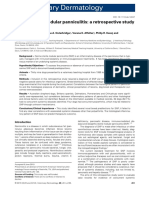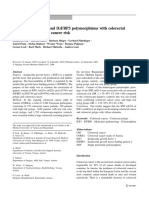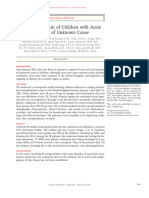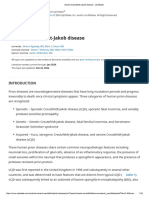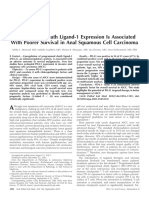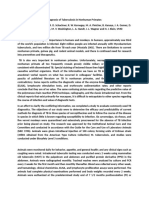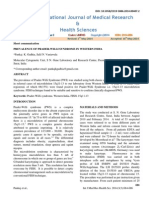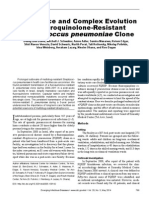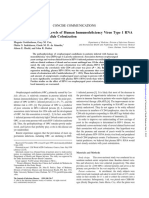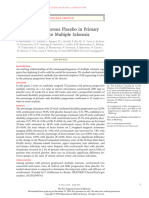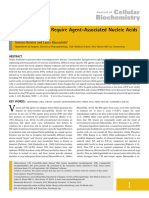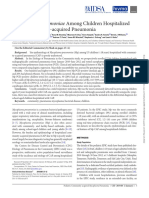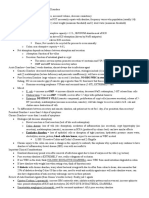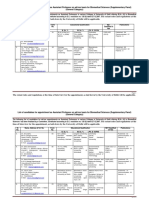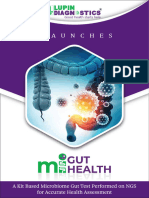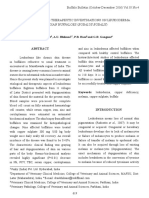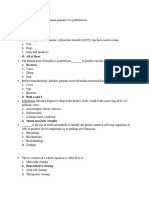CJD Genetics
CJD Genetics
Uploaded by
isleofthedeepCopyright:
Available Formats
CJD Genetics
CJD Genetics
Uploaded by
isleofthedeepCopyright
Available Formats
Share this document
Did you find this document useful?
Is this content inappropriate?
Copyright:
Available Formats
CJD Genetics
CJD Genetics
Uploaded by
isleofthedeepCopyright:
Available Formats
Articles
Genetic risk factors for variant CreutzfeldtJakob disease: a genome-wide association study
Simon Mead, Mark Poulter, James Uphill, John Beck, Jerome Whiteld, Thomas E F Webb, Tracy Campbell, Gary Adamson, Pelagia Deriziotis, Sarah J Tabrizi, Holger Hummerich, Claudio Verzilli, Michael P Alpers, John C Whittaker, John Collinge
Summary
Background Human and animal prion diseases are under genetic control, but apart from PRNP (the gene that encodes the prion protein), we understand little about human susceptibility to bovine spongiform encephalopathy (BSE) prions, the causal agent of variant CreutzfeldtJakob disease (vCJD). Methods We did a genome-wide association study of the risk of vCJD and tested for replication of our ndings in samples from many categories of human prion disease (929 samples) and control samples from the UK and Papua New Guinea (4254 samples), including controls in the UK who were genotyped by the Wellcome Trust Case Control Consortium. We also did follow-up analyses of the genetic control of the clinical phenotype of prion disease and analysed candidate gene expression in a mouse cellular model of prion infection. Findings The PRNP locus was strongly associated with risk across several markers and all categories of prion disease (best single SNP [single nucleotide polymorphism] association in vCJD p=2510; best haplotypic association in vCJD p=110). Although the main contribution to disease risk was conferred by PRNP polymorphic codon 129, another nearby SNP conferred increased risk of vCJD. In addition to PRNP, one technically validated SNP association upstream of RARB (the gene that encodes retinoic acid receptor beta) had nominal genome-wide signicance (p=1910). A similar association was found in a small sample of patients with iatrogenic CJD (p=0030) but not in patients with sporadic CJD (sCJD) or kuru. In cultured cells, retinoic acid regulates the expression of the prion protein. We found an association with acquired prion disease, including vCJD (p=5610), kuru incubation time (p=0017), and resistance to kuru (p=2510), in a region upstream of STMN2 (the gene that encodes SCG10). The risk genotype was not associated with sCJD but conferred an earlier age of onset. Furthermore, expression of Stmn2 was reduced 30-fold post-infection in a mouse cellular model of prion disease. Interpretation The polymorphic codon 129 of PRNP was the main genetic risk factor for vCJD; however, additional candidate loci have been identied, which justies functional analyses of these biological pathways in prion disease. Funding The UK Medical Research Council.
Lancet Neurol 2009; 8: 5766 Published Online December 11, 2008 DOI:10.1016/S14744422(08)70265-5 See Reection and Reaction page 25 Medical Research Council Prion Unit and Department of Neurodegenerative Disease, Institute of Neurology, Queen Square, London, UK (S Mead PhD, M Poulter BSc, J Uphill BSc, J Beck BSc, J Whiteld MA, T Webb MRCP, T Campbell BSc, G Adamson BSc, P Deriziotis MSc, S J Tabrizi PhD, H Hummerich PhD, M P Alpers FRS, J Collinge FRS); Papua New Guinea Institute of Medical Research, Goroka, East Highlands Province, Papua New Guinea (J Whiteld); Centre for International Health, Curtin University, Perth, Australia (M P Alpers); and Department of Epidemiology and Population Health, London School of Hygiene and Tropical Medicine, London UK (C Verzilli PhD, J C Whittaker PhD) Correspondence to: John Collinge, MRC Prion Unit and Department of Neurodegenerative Disease, Institute of Neurology, Queen Square, London WC1N 3BG, UK j.collinge@prion.ucl.ac.uk
Introduction
Prion diseases are transmissible, fatal, neurodegenerative conditions of human beings and animals that are caused by the autocatalytic misfolding of host-encoded prion protein (PrP).1 An epizootic prion disease, bovine spongiform encephalopathy (BSE), widely exposed the population of the UK (and, to a lesser extent, many other populations) to prion infection. The subsequent diagnosis of variant CreutzfeldtJakob disease (vCJD) in young British adults, and the experimental nding that this was caused by BSE-like prions,24 resulted in a major public and animal health crisis. Although the number of recorded clinical cases of vCJD to date has been small (~200) in relation to the millions of people who were potentially exposed, how many individuals were infected is unclear. The clinically silent incubation period in human beings can exceed 50 years,5 and estimates of the prevalence of subclinical infection made on the basis of screening archived surgical specimens predicts that thousands of individuals in the UK are infected.6 Blood transfusion seems to be an ecient route of secondary transmission7 but no screening test to ensure the safety of
www.thelancet.com/neurology Vol 8 January 2009
blood products is yet available. Case control studies have identied no unusual occupational, dietary, or other exposure to BSE prions among patients with vCJD,8 which suggests that genetic factors might be crucial. A known genetic factor for susceptibility to prion disease is the common single nucleotide polymorphism (SNP) at codon 129 in PRNP, the gene that encodes PrP in human beings. Here, either methionine (~60% allele frequency in Europeans) or valine is encoded.9 All patients with vCJD who have been genotyped are homozygous for methionine,10 which represents the strongest association to date of a common genotype with any disease. Although this is a powerful eect, about a third of the exposed UK population have this genotype. An important role for other genetic loci is supported by the results of mouse quantitative trait locus studies, which have identied many regions that are not linked to Prnp but control the highly variable prion disease incubation periods,11,12 including that of BSE prions.13 The importance to public health of understanding susceptibility to BSE prion infection in human beings is therefore clear. We undertook a genome-wide association study with 100K and 500K Aymetrix arrays with all available samples
57
Articles
from white British patients with vCJD (n=119) compared with our own and publicly available UK control data, which was genotyped by the Wellcome Trust CaseControl Consortium (WTCCC). Because all available vCJD samples from the UK were included in the discovery phase, we went on to compare the top-ranked SNP associations and additional SNPs at the PRNP locus with a large and diverse collection of patients with prion disease, including those with iatrogenic CJD (iCJD), sporadic CJD (sCJD), and kuru.
Methods
Samples
Figure 1 shows the four tiers of genotyping in the study. Samples were obtained from 119 patients with vCJD (ten patients with probable vCJD and 109 patients with denite vCJD) who were diagnosed at the National Prion Clinic (NPC), London, or the National CJD Surveillance Unit (NCJDSU), Edinburgh, between 1995 and 2005 according to established criteria. Patients who acquired iatrogenic vCJD through blood transfusion were not included in this series. All patients with vCJD were thought to have acquired the disease in the UK and were of white British ethnic origin (60% were men; mean age of disease onset was 298 [SD 109] years). Samples were obtained from 506 patients with probable or denite sCJD diagnosed according to established criteria and from 28 patients with iCJD related to exposure to cadaver-derived growth hormone in the 1980s or earlier; these samples were obtained from the NPC or the NCJDSU or from other clinical colleagues in the UK. All patients were from the UK or elsewhere in northern Europe. Although most patients were of white British ethnic origin, and all patients of known non-white ethnic origin were excluded, this information was based on names and geographical location for some samples. 325 patients had pathologically conrmed sCJD and 181 patients had a diagnosis of probable sCJD with a high specicity according to published WHO criteria, although some of these patients might have had a neuropathological diagnosis made elsewhere.14 Mean age of disease onset was 682 (SD 120) years for the patients with sCJD and 311 (63) years for the patients with iCJD. 50% of the samples from patients with sCJD were from men. Before 1987, kuru surveillance was done by many dierent investigators; however, from 1987 to 1995 surveillance was done solely by the Kuru Surveillance Team of the Papua New Guinea Institute of Medical Research. From 1996, kuru surveillance was strengthened: a eld base and basic laboratory for sample processing and storage were established in the village of Waisa in the South Fore, and a wide collection of population control samples were taken.5 The samples from patients with kuru (n=151) were taken from young children, adolescents, and adults during the peak of the epidemic and from recent cases of kuru with long incubation times in elderly patients. The patients lived in the South Fore (n=53), North Fore
For more on the criteria see http://www.advisorybodies.doh. gov.uk/acdp/tseguidance/ tseguidance_annexb.pdf
For WTCCC genotype data see http://www.wtccc.org.uk/info/ access_to_data_samples.shtml
(n=40), Gimi (n=3), and Keiagana (n=10) regions; linguistic group was not known in 45 patients. Elderly women who had been exposed to kuru were dened as aged older than 50 years in 2000 and from a region that had been exposed to kuru: South Fore (n=74), North Fore (n=36), Gimi (n=13), and Keiagana (n=2). The modern-day healthy population from the exposed region was obtained by matching each elderly woman to at least two current residents of the same village who were aged less than 50 years in 2000. These mostly came from the South Fore, with some from the North Fore, and a small number of individuals from Gimi, Keiagana, and Yagaria linguistic groups, as indicated. First-degree relatives of the elderly women, identied by either genealogical data or microsatellite analysis, were excluded from these groups. 155 samples were from volunteers recruited by the Medical Research Council Prion Unit from the National Blood Service (NBS). Information was collected about their sex, age, ethnic origin, and birthplace divided into 12 regions. 90 samples genotyped with Aymetrix arrays were selected to match the vCJD collection for white British ethnic origin, birthplace (by 12 regions in UK, each region was represented in patients and controls with the same ranking), and sex (proportion of men with vCJD was 60%, and the proportion of men in the NBS controls was 57%). A further 575 UK control samples were obtained for the replication phases of the study (730 healthy controls in total) from the NBS (95 white, random, healthy young blood donors) and from the European Collection of Cell Cultures (ECACC) human random control DNA collection (480 blood donors of known age and sex). No selection was done in the replication phase of the study. Not all control samples were genotyped for all replication studies; however, there is no reason to expect signicant genetic heterogeneity in our collections of UK blood donors based on analyses of the UK population done by the WTCCC and others.15 All UK control samples contained good quality unamplied DNA. The mean age at sampling was 387 (SD 108) years, and 51% were men. In addition, we used publicly available UK control data generated by the WTCCC. In brief, 1500 samples from the 1958 British Birth Cohort and 1500 samples from the UK Blood Service Control Group were genotyped with commercial Aymetrix 500K arrays with a Bayesian robust linear model with Mahalanobis distance (BRLMM) algorithm. We did not detect any duplicate individuals between the UK control collections nor any signicant dierences in allele frequency between our in-house UK control collections or those genotyped by the WTCCC. The clinical and laboratory studies were approved by the local research ethics committee of University College London Institute of Neurology and National Hospital for Neurology and Neurosurgery and by the Medical Research Advisory Committee of the Government of Papua New Guinea. The full participation of the Papua New Guinea communities was established and maintained through discussions with village leaders, communities, families,
www.thelancet.com/neurology Vol 8 January 2009
58
Articles
and individuals. Most of the UK samples were obtained with written consent from patients or next of kin; however, where this was not available, for example, for archival vCJD tissue obtained at post-mortem examination, we obtained the specic approval of our local ethics committee for the use of these samples in the research.
117 patients with vCJD vs 84 in-house controls from UK National Blood Service genotyped with Aymetrix 500k and 100k arrays with a dynamic model (DM) algorithm
Procedures
For the samples from patients with vCJD, genomic DNA was mostly extracted from peripheral blood, although 45 samples were extracted from brain tissue. For a few samples, whole-genome amplication, either with a 29 protocol called multiple displacement amplication (MDA; Geneservice, Cambridge, UK; ten samples) or GenomePlex Complete Whole Genome Amplication Kit (WGA2; Sigma, UK; two samples) was necessary. For the samples from patients with sCJD or iCJD, wholegenome amplication with either MDA in 138 samples or WGA2 in 29 samples was needed. Most of the samples from patients with sCJD and iCJD were extracted from blood, although DNA from eight samples in the iCJD group and 70 samples from the sCJD group was derived from brain tissue. 112 samples from patients with sCJD were sent as DNA to the MRC Prion Unit for analysis, most of which were extracted from blood. Genomic DNA was usually extracted from peripheral blood. PAXgene blood-derived RNA samples were also collected (Reanalytix, QIAGEN, UK). DNA from degraded archival kuru sera was isolated by QIAamp Blood DNA minikit (QIAGEN, UK) followed by whole-genome amplication with WGA2 in all but seven samples. The validation of this process for the degraded kuru samples has been reported elsewhere.16 Good-quality genomic DNA extracted from blood was available for 278 of 285 (98%) healthy controls from Papua New Guinea and 122 of 125 (98%) healthy elderly women with many exposures to kuru at mortuary feasts. All control samples from Papua New Guinea were extracted from blood. All DNA samples were checked for degradation on 1% agarose gel and stored at 50 ng/L in low-concentration tris-EDTA buer. Rocky Mountain Laboratory (RML) prion-infected mouse brain homogenate (0001%) or mock-infected brain homogenate from wild-type CD-1 mice (0001%) was used to infect GT-1 hypothalamic neuronal cells. 5000 cells were seeded into 96-well plates and incubated with either homogenate in standard growth medium (Opti-MEM supplemented with 10% fetal calf serum and 1% penicillin/ streptomycin [Invitrogen, CA, USA]). The inoculum was removed after 3 days and the cells were split 1:8. Cells were then split 1:8 twice more at intervals of 3 days. High levels of prion infectivity were conrmed with the scrapie cell assay.17 Prion-infected and mock-infected cells were maintained in standard growth medium at 37C in 5% CO. Total RNA was extracted in triplicate with the RNeasy Midi kits (QIAGEN, UK) according to the manufacturers
www.thelancet.com/neurology Vol 8 January 2009
117 patients with vCJD vs 3083 UK controls (2999 from Wellcome Trust Case Control Consortium and 84 from UK National Blood Service) genotyped with Aymetrix arrays by use of a Bayesian robust linear model with Mahalanobis distance classier algorithm
35 top-ranked SNPs genotyped with MGB probes 119 patients with vCJD vs 3692 UK controls (2999 from Wellcome Trust Case Control Consortium and 730 from UK National Blood Service) 506 sCJD vs 3692 UK controls (as above) 28 iCJD vs 3692 UK controls (as above) 151 patients with kuru (aged <25 years vs >25 years) 125 elderly women who are resistant to kuru vs 562 healthy young Fore
17 SNPs linked to PRNP and 1325 spaced autosomal SNPs that are not associated with vCJD, genotyped with a GoldenGate genotyping assay 119 patients with vCJD vs 344 UK controls from the European Collection of Cell Cultures 485 patients with sCJD vs 344 UK controls (as above) 28 patients with iCJD vs 344 UK controls (as above) 143 patients with kuru (aged <25 years or >25 years at onset) 122 elderly women who are resistant to kuru vs 282 healthy young Fore
Figure 1: Flowchart of the genotyping in the tiered study For each tier, the patient and control sample collections used are subsets of those genotypes in the minor groove-binding (MGB) probe study. In the rst two tiers, the 117 samples from patients with vCJD are a subset of the 119 used in tiers three and four. In the second tier, the 84 samples from the UK National Blood Service are a subset of the 730 used in the third tier. In the nal tier, the 485 samples from patients with sCJD, the 143 samples from patients with kuru, the 122 samples from elderly women, and the 282 samples from healthy young Fore are all subsets of the samples used in the third tier.
instructions, from prion-infected and mock-infected cells that had been grown on 10-cm-diameter plates. RNA was eluted in RNAase-free water and stored at 80C. RNA samples adjusted to a concentration of 250 ng in 5 L were incubated at 50C for 30 mins with an equal volume of Glyoxyl (Ambion, Warrington, UK) loading dye containing ethidium bromide. Samples were run on a 15% agarose mini-gel in 1 NorthernMAx glyoxyl-based gel prep and running buer (Ambion) at 100 mV for 90 min to check sample integrity. RNA was then sent to AROS Applied Biotechnology AS (Denmark) for the following microarray analyses according to Aymetrix standard protocols: rst and second strand complementary DNA synthesis was done with the SuperScriptII System (Invitrogen) from 5 g RNA (a minor modication was made to the protocol by using an oligo-dT primer that contained a T7 RNA polymerase promoter site); labelled antisense RNA (cRNA) was prepared with the BioArray High Yield RNA Transcript Labelling Kit with biotin-labelled CTP and UTP (Enzo Life Sciences, NY, USA) and unlabelled NTPs. Unincorporated nucleotides were removed using RNeasy columns (QIAGEN). 15 g of cRNA was fragmented, loaded on to the Aymetrix mouse expression array 430_2.0 probe array cartridge, and hybridised for 16 h. Arrays were washed, stained in the Aymetrix uidics station and scanned with
59
Articles
For the PLINK toolset see http://pngu.mgh.harvard.edu/ ~purcell/plink/index.shtml
a confocal laser-scanning microscope (GeneChip Scanner 3000 System with Workstation and Autoloader). The following sample comparisons were made in the association studies: vCJD versus UK controls genomewide with Aymetrix array data; vCJD, sCJD, and iCJD versus UK controls in a validation and replication study with minor groove-binding [MGB] probes; healthy elderly women who were exposed to kuru at mortuary feasts versus geographically matched young individuals from the Eastern Highlands of Papua New Guinea in the replication study; young patients with kuru versus older kuru patients in the replication study. Figure 1 shows the tiered nature of the study. Subsets of each sample group have been used in previous studies of PRNP codon 129.18 The comparison of young versus old patients with kuru was based on a hypothesis derived from mouse models that states that genetic factors control the incubation time of human prion diseases.12 The incubation time of middle-aged or elderly patients who died of kuru at the peak of the epidemic cannot be calculated with precision and might have been many decades. Incubation times of up to 50 years or longer have been recorded in recently diagnosed patients,5 whereas children, adolescents, or young adults have a limited incubation time.5 Because the kuru collection was a mixture of samples from young and old patients, we hypothesised a priori that greater dierences would be found between young people with kuru and old people with kuru than between people with kuru versus modern young healthy Fore. This strategy was supported by the precedent of homozygosity at codon 129 of PRNP, which was strongly associated with young versus old kuru, but was not signicant in a comparison of all kuru with healthy Fore.
Genotyping and statistical analysis
We used the Aymetrix 100K and 500K arrays (early access, EA-500K), which use four restriction enzymes in total. Our rst casecontrol study used data generated by the Aymetrix DM (dynamic model) algorithm from 117 samples of patients with vCJD (two samples were not suitable for use with Aymetrix arrays) and 90 UK controls matched for birthplace. The 500K product is comprised of two arrays each of about 250K digested with the restriction endonucleases NspI or StyI; the 100K product is comprised of two arrays each of about 50K digested with the restriction endonucleases XbaI and HindI. Genotypes were called by the dynamic model (DM) and subsequently by BRLMM algorithms. Samples from patients with vCJD were repeated if the DM call rate was less than 85% or the BRLMM call rate was less than 90% and samples were excluded if they underperformed by these criteria (vCJD [n=0], NBS [n=6], WTCCC [n=5]). The median and mean BRLMM call rates (all non-WTCCC samples and all arrays) were 990% and 985%. No samples were excluded for excess or low heterozygosity. One duplicate sample but no related individuals were identied. With genome-wide SNP data, the PLINK toolset for whole-genome association
60
and population-based linkage analysis enables estimates of the relatedness of individuals. For the purposes of conrming unrelatedness, this can be expressed as a probability for identity by descent (IBD)=0 using complete linkage agglomerative clustering. This probability was greater than 075 for all study pairwise comparisons. No samples were identied as ethnic outliers by use of identity by state clustering. Genotype data quality analysis and ltering was done with PLINK. From 598 676 unltered SNPs, the following were excluded from further analysis by standard quality control: monomorphic SNPs or those not genotyped by EA-500K or WTCCC arrays (n=170 334); greater than 10% missing genotypes in vCJD (n=66 659) or WTCCC (n=9828); evidence of HardyWeinberg disequilibrium (exact test, p<0001) in our UK samples (n=4873) or (exact test, p<1010) in WTCCC samples (n=7673); minor allele frequency less than 001 in vCJD and WTCCC samples (n=57 853); allelic test for dierences in our inhouse UK samples versus WTCCC (p<0001; n=1888). After this trimming, 410 287 SNPs remained for testing in 117 patients with vCJD versus 3083 UK controls (84 in-house UK controls and 2999 WTCCC samples). A more stringent lter applied additional thresholds of less than 3% missing data overall, and minor allele frequencies greater than 3% (n=288 908 SNPs remaining). These stringently ltered data were assessed for whether the skewed quartile quartile (QQ) plots (gure 2) were caused by cryptic population stratication between the UK control and vCJD groups or alternatively by inaccurate SNP genotyping. The absence of a signicantly skewed QQ plot in the stringently ltered data supports the hypothesis that SNPs were inaccurately called, probably on the EA-500K platform. Subsequently this was conrmed by concordance testing with the GoldenGate platform. Candidate SNPs for further study were identied in stringently ltered dataset or after standard ltering if there was additional evidence of genotype accuracy, by identifying an association signal in nearby SNPs in strong linkage disequilibrium with the candidate SNP. As a further test to identify false-positive associations related to dierential genotyping accuracy between cases and controls, we validated (>99% concordance) all genotypes shown in vCJD and in-house UK controls with an independent platform (MGB probe and quantitative PCR) before attempting replication in other categories of prion disease with the same technology (35 SNPs were tested in this way). To maximise coverage, a further 17 SNPs were chosen from the PRNP locus (by maximising pairwise r with HapMap build 35 using Haploview) and genotyped with GoldenGate technology. In total 52 SNPs were genotyped for association studies further to the discovery phase. PLINK was used for association and permutation testing. The primary analysis was an allelic test with use of empirical p values if any cell count was less than 15. A secondary analysis implemented genotypic,
www.thelancet.com/neurology Vol 8 January 2009
Articles
A
400
B
150
C
150
D
100
80 300 100 Ordered data 100 60 200 40 50 100 20 50
0 0 5 10 15 (quantiles) 20
0 0 5 10 15 (quantiles) 20
0 0 5 10 15 (quantiles) 20
0 0 5 10 15 20 (quantiles)
Figure 2: QQ (quartilequartile) plots of dierent stages of quality control (A) Unltered allelic test of vCJD samples versus all UK samples (internal and Welcome Trust Case Control Consortium [WTCCC]) data. (B) Standard ltering allelic test of vCJD versus all UK samples (internal and WTCCC data). (C) Standard ltering with allelic test of vCJD versus only internal UK samples. (D) High-stringency ltering. With standard ltering, the ination factor used for genomic control of confounding factors was estimated as 106 (101109). Red dots=observed data. Blue lines=expected data. Broken blue lines=95% CI for expected data.
dominant, and recessive models, with empirical signicance if necessary, controlling for the four tests done. Imputation of codon 129 genotype was done by the PLINK proxy-impute command (multimarker tagging) with dense SNP data around PRNP, including rs1799990, generated in 344 in-house UK controls. A nominal genome-wide signicance threshold of p<510 was used in the primary analysis in concordance with the WTCCC. Owing to the large number of SNPs that were tested, this threshold takes into account multiplehypothesis testing. In the replication phase of the study, the small number of tested SNPs permits a less stringent threshold of p<0001. Population structure was analysed with IBS clustering (implemented through PLINK) and principle components analysis (implemented through the Eigenstrat package19). Genome-wide data that were ltered to high stringency were used to compare samples from patients with vCJD and UK controls with PLINK and Eigenstrat (no signicant eigenvectors were detected with default procedures). A separate low-density study was done with GoldenGate technology for several reasons: to investigate genotype accuracy in the SNPs ltered out by the highstringency ltering step; to provide evidence with regard to the population structure in the samples from Papua New Guinea, which was previously unknown; to provide evidence that concordant genotypes consistent with the healthy population frequencies could be obtained from the amplied degraded samples from patients with kuru. 17 additional SNPs were genotyped to provide dense coverage of the PRNP locus, which is a region that confers susceptibility to prion disease, with a high
www.thelancet.com/neurology Vol 8 January 2009
probability of novel susceptibility being discovered here. These 17 SNPs complemented an existing dataset of 25 SNPs from the earlier genome-wide phase of the study. SNPs were selected from standard stringency ltered data in the genome-wide phase of the study; all autosomes were equally represented, with a median intermarker distance of 13 Mb. 1523 individuals were genotyped for 1325 SNPs: 344 randomly selected, nonrelated, white blood donors from the UK provided by the ECCCs; 119 patients with vCJD; 485 patients with sCJD; 28 patients with iCJD; 143 patients with kuru; 122 elderly women who are resistant to kuru and were born before 1950; and 282 young individuals from the kuru region matched to the elderly women by village of residence (gure 1). These patients were a subset of those included in the replication studies. SNPs were ltered for association with vCJD by comparison with UK controls by best permuted p<0001 from any of four genetic models (allelic, trend, genotypic, or recessive) with the GoldenGate platform at the St Bartholomews Hospital Genome Centre. Genotyping quality was assessed by HardyWeinberg equilibrium (excluding those assessed by exact test p<0001) and visual inspection of all genotype clusters with Beadstudio version 3.1. The overall genotype call rate was 997%, and concordance of duplicate samples was excellent (nine WGA2 degraded amplied kuru samples [concordance 997%] and 20 healthy control duplicates [concordance >999%]). This study conrmed that the skew in the QQ plots was caused by inaccurate genotyping of SNPs in our genomewide study that were not adequately ltered by the lowstringency criteria. For Eigenstrat, ten eigenvectors were
For more on the Genome Centre see http://www. bartsandthelondon.nhs.uk/ research/core_facilities_to_ support_research.asp#genome
61
Articles
Chromosome rs1799990 rs6107516 rs6116492 rs1460163 rs6794719 20 20 20 8 3
Locus 4628251 4625092 4646626 24777543
Minor allele G A T T
Major allele vCJD genotypes UK control genotypes A G G G A 119/0/0 117/2/0 104/12/1 7/25/86 3/31/84 294/324/81 1960/1227/227 2979/104/0 31/657/2734 346/1465/1596
Model p (vCJD) A A A R A 2010 2510 8210 5610 1910
OR 385 (961552) 371 (209659) 69 (30160) 25 (1737)
80390003 A
Genetic models: A=allelic; G=genotypic.
Table 1: Discovery tests of rs1799990 and four novel candidate SNPs in patients with vCJD and UK controls
Resistance to kuru despite exposure Elderly women Healthy exposed to kuru young Fore rs1799990 rs6116492 rs1460163 rs6794719 16/86/23 80/37/2 30/77/16 5/47/63 112/287/163 393/151/18 140/144/40 26/118/136 Model G A R A p value 0001 0848 25104 012
Early-onset and late-onset kuru Young kuru Older kuru Model (age <25 years) (age >25 years) 16/18/25 47/11/0 23/29/5 4/25/27 9/71/12 57/20/0 26/42/23 7/33/47 G A A A p value (kuru incubation) 9110 044 0017 0687
Combined p value*
2210 5710
Genetic models: A=allelic; G=genotypic; R=recessive. *Fishers method.
Table 2: rs1799990 and three novel candidate SNPs in samples from Papua New Guinea
iCJD genotypes rs1799990 rs6107516 rs6116492 rs1460163 rs6794719 4/13/11 9/12/7 28/0/0 0/7/21 1/8/19
UK control genotypes 294/324/81 1960/1227/227 2979/104/0 31/657/2734 346/1465/1596
Model A R A A A
p (iCJD)
sCJD genotypes
Model G G A A A
p (sCJD) 2310 3610 030 083 008
Results
After standard quality control for call rate and minor allele frequency, HardyWeinberg disequilibrium, and dierences between control datasets, we analysed 410 287 SNPs in the primary analysis. QQ plots showed an excess of large allelic test statistics (gure 2) owing partly to the comparison between cases and controls among platforms and laboratories and was completely resolved by stringent ltering by call rate and minor allele frequency, leaving about 300K SNPs for association testing. Comparison of these stringently ltered data between vCJD and our own UK controls, ECACC controls, and WTCCC controls with Eigenstrat and GC methods did not provide evidence of signicant population stratication; therefore, association statistics were not corrected. Similarly, we found no evidence of population stratication in comparisons of 1325 SNPs in replication cohorts (sCJD, iCJD, and control groups from the UK) or between patients with kuru, elderly women who were resistant to kuru, and healthy Fore from Papua New Guinea. In the stringently ltered data, two SNPs were signicant at the genomewide level (p<510) on the basis of allelic tests: rs6107516 in the intron of PRNP and rs6794719 in an intergenic region between RARB and THRB, which encodes thyroid hormone receptor beta (gure 3). A block of linkage disequilibrium that was larger than ~100 kb and included all of PRNP was shown by 25 SNPs (gure 3). We added 17 more SNPs from vCJD and UK controls, including PRNP codon 129 (rs1799990). Unsurprisingly, rs6107516, which is located in the intron of PRNP and is in moderately strong linkage disequilibrium with codon 129 (rs1799990, r=06), was the top-ranked single SNP in the discovery phase. All patients with vCJD who have been genotyped to date are homozygous for
www.thelancet.com/neurology Vol 8 January 2009
2710 307/98/101 0002 062 066 003 320/100/55 483/22/0 7/93/396 61/207/207
Genetic models: A=allelic; G=genotypic; R=recessive.
Table 3: Replication tests of rs1799990 and four novel candidate SNPs in patients with iCJD, patients with sCJD, and UK controls
generated through default procedures and outlier detection (6 of 826 samples from Papua New Guinea were removed). No signicant eigenvectors (p>001) were identied between patients with sCJD or iCJD and UK controls, or between patients with kuru, elderly women who are resistant to kuru, and healthy young Fore (ve comparisons in total). The Gene Expression Analysis Software (MAS 5.0) was used to analyse the raw image les from the quantitative scanning, which resulted in les that contained background corrected values for the probes. Signicance analyses to compare prion versus mock-infected cells used a two-class unpaired test with a BenjaminiHochberg (false discovery rate) p-value correction.
Role of the funding source
The sponsors had no role in the study design, data collection, data analysis, data interpretation, or writing of the report. Simon Mead and John Collinge had full access to all the data in the study and nal responsibility for the decision to submit for publication.
62
Articles
rs1799990A (MM at PRNP codon 129). rs6107516 was most strongly associated in an allelic model (p=2510; OR 385, 95% CI 961552). From the 25 SNPs in the discovery phase, codon 129 of PRNP was best tagged by a two SNP haplotype formed by rs6031692 and rs6107516 (r=07, based on Hapmap build 35 data) with a haplotypic association of p=110. To test for more association at the locus, we conditioned for the association of codon 129 by imputing this genotype and including only methionine-homozygous UK controls from the WTCCC series. We thus identied evidence of additional genetic risk at this locus. rs6116492, which is downstream of PRNP and also in strong linkage disequilibrium with rs1799990, had a frequency of 006 in patients with vCJD and 0017 in UK controls (allelic model p=8210; 0022 in 1544 UK controls with an imputed codon 129 methionine homozygous genotype; allelic model p=0001, OR 263, 95% CI 143482). rs6116492 is located in an intergenic region between PRNP and PRND, which encodes prion-like protein doppel. Genetic risk factors for sCJD have previously been identied upstream and downstream of PRNP but not for vCJD.20,21 Because we cannot guarantee that the rs1799990 genotype has been imputed perfectly, we also compared cases of vCJD (n=119) with in-house UK controls genotyped at rs1799990 and rs6116492 (n=701); we again found a signicant, independent association of rs6116492, both by haplotype test conditioned on codon 129 (PLINK, likelihood ratio test with one degree of freedom; p=0037), or simply by excluding controls with methionine/valine or valine/valine encoded at codon 129 genotypes followed by an allelic test (119 patients with vCJD vs 294 in-house UK controls with the genotype that encodes methionine/methionine at codon 129; p=002). SNP-1368 (rs1029273C, 24 466 base pairs upstream of codon 129), which we and others have conrmed to be associated with sporadic CJD but not vCJD, also showed no evidence of association with vCJD independent of codon 129.20,21
A
1E08 1E07 1E06 1E05 p 1E04 0001 001 01 1 2460 2465 2470 2475 2480 2485 2490 2495 Chromosome 3 (Mb) THRB RARB 01 1 1E04 0001 001 rs6794719 p (trend test) p (permuted best of 4 models)
Because we tested the entire collection of samples from white British patients with vCJD (the majority of cases of vCJD), we then looked to closely related prion diseases to replicate independently and more broadly candidate SNPs with risk of prion disease. We tested for the association of rs6794719, rs6116492, and 33 other topranking SNP associations from the vCJD study in patients with iCJD who were exposed to prion disease through cadaver-derived growth hormone therapy versus UK controls (n=28); 506 patients with sCJDa worldwide disease of uniform incidence that aects about 12 million people per yearversus UK controls. We also tested patients with kuru and healthy elderly women who were exposed to but survived the kuru epidemic from the Eastern Highlands Province of Papua New Guinea. In the groups from Papua New Guinea, we tested whether candidates for genetic risk of vCJD were associated with kuru incubation time (by comparison with a cohort of young-onset kuru [n=59] versus oldonset kuru [n=92]) or resistance to kuru, by comparison of elderly female survivors (n=125) with the young population (n=280526). Homozygosity at codon 129 of PRNP was signicantly associated with risk of iCJD (p=2710), sCJD (p=2310), and tests done in Papua New Guinea (Fishers method p=2210; tables 1 and 2). rs6794719A was associated with the risk of vCJD at a nominal genome-wide signicance of p=1910. The more frequent allele, rs6794719A, was also associated with disease risk in the small collection (n=28) of patients with iCJD (p=0030; table 3) but not those with sCJD, kuru, or resistance to kuru. From the 33 top-ranked SNPs that failed to achieve genome-wide signicance in patients with vCJD, the strongest overall evidence of association in replication cohorts was for rs1460163 (combined p=6310 by Fishers method across orally acquired prion disease categories [combination of vCJD and Papua New Guinea
C
1E20 1E18 1E16 1E14 1E12 1E10 1E08 1E06 1E04 001 1 rs1799990
B
1E06 1E05
rs1460163
8020 8025 8030 8035 8040 8045 8050 8055 Chromosome 8 (Mb) STMN2 IL7
458
460 462 464 Chromosome 20 (Mb) PRND PRNP
466 PRINT
Figure 3: Physical location and p of allelic test and best of four genetic models (A) SNPs between THRB and RARB, including rs6794719. (B) SNPs upstream of STMN2 including rs1460163. (C) SNPs at the PRNP locus, including rs1799990, rs6107516, and rs6116492, showing trend test (lled circles) and a test comparing vCJD with UK controls with codon 129 methionine homozygous genotypes (empty circles [imputed for WTCCC controls]).
www.thelancet.com/neurology Vol 8 January 2009
63
Articles
100
500
90
400
Raw expression intensities
80
300
70
200
60 Age of clinical onset (years)
100
0 50
NBHMG Stmn2
RML
NBHMG Rarb
RML
40
Figure 5: Boxplot of Stmn2 and Rarb expression Expression of Stmn2 and Rarb in mouse neuronal cells (GT-1) treated with homogenate of healthy brain (NBHMG) or Rocky Mountain Laboratory scrapie brain homogenate (RML). Median is shown as a thick red horizontal line, IQR by boxes, and largest and smallest observations by whiskers.
30
20
10
0 GG AG rs1460163 genotype AA
Figure 4: Age of clinical onset of vCJD (red) and sCJD (blue) patients against rs1460163 genotype Clinical onset was dened as the age of the rst symptom that progressed into a neurological or neuropsychiatric condition due to prion disease. The central bars indicate mean age of onset; boxes indicate 95% CI of the mean.
tests]). rs1460163 was associated with age of kuru onset (p=0017) and resistance to kuru (p=25104), with the same highest-ranking risk allele for vCJD and kuru. rs1460163 is located in a large block of linkage disequilibrium that extends just 5 to STMN2 (gure 3). Other SNPs tested in the replication phase were either poorly genotyped in the discovery phase (concordance <99%), or showed no evidence of association in any prion disease category additional to vCJD (p>0001; best from four risk models).
64
We then analysed the clinical and molecular phenotype of UK prion disease for rs1460163, rs6116492, and rs6794719. In patients with sCJD, there was a signicant modifying eect of the risk allele, with clinical onset 5 years earlier for those with risk genotype rs1460163AA compared with those with GG (linear regression of log-transformed age of onset against genotype p=002; gure 4). In patients with vCJD, the mean age of onset for genotype AA was 3 years earlier than for those with GG, but this was not statistically signicant (p=026). By use of a linear regression model with disease type as a factor, the rs1460163AA allele was associated with age of onset in sCJD and vCJD (log-transformed p=001) and was also independent of rs1799990. No eect was seen on year of presentation, which in part will determine incubation time in vCJD, but this analysis is confounded by uncertainty in the time of exposure. No eect was seen on sCJD PrPSc strain type as dened by partial protease K digestion and western blot. rs6116492 and rs6794719 had no eect on prion disease phenotype. In a cellular model of mouse prion disease, the expression of Stmn2 was profoundly altered by infection with prions. This dierence was shown by comparison of the transcriptome of prion-infected and prion-uninfected cells in culture. Mouse hypothalamic neuronal (GT-1) cells that were infected with mouse brain homogenate (NBHMG) or RML-infected brain homogenate were analysed with the Aymetrix Mouse Expression Array 430_2.0. Comparison of the expression between NBHMG and RML showed that
www.thelancet.com/neurology Vol 8 January 2009
Articles
Stmn2 is signicantly (p=3610) downregulated by a factor of about 30 and ranked tenth out of more than 21 537 genes that were represented by one or more transcripts on the array (gure 5). In this study, the expression of 543 of 21537 (25%) genes was altered, with a fold change of more than 283 (corrected Benjamini Hochberg method). Neither RARB nor STMN2 is signicantly expressed in human blood cells, which obviates the analysis of the correlation of gene expression with genotypic risk in a large collection of samples.
Discussion
We describe the rst genome-wide study of genetic risk in a human prion disease and replication of a small number of top-ranking candidate SNPs. Further genetic studies of human prion disease, including more extensive replication studies, are warranted because our power was limited by the small size of the vCJD sample and an early generation platform was used. Owing to the rarity of the disease, all available samples were used; the use of amplied DNA in a proportion of cases might have also aected the quality of genotyping. For these reasons, we used highly stringently ltered data and veried genotypes from candidate SNPs with an in-house assay. The potential exists for a larger scale study in sCJD that capitalises on decades of surveillance for human prion diseases across Europe and the rest of the world; however, this disease is undoubtedly more heterogeneous than vCJD. The potential overlap in pathogenesis between vCJD and the other prion disease categories used in the replication phases of the study must also be considered. The pathogenesis of vCJD contrasts with the replication cohorts in terms of prion strain (all groups), tissue distribution, and route of infection (for iCJD and sCJD). Furthermore, in the case of our large collection from Papua New Guinea, the linkage-disequilibrium relationship between candidate SNPs and a putative functional SNP is not known and can therefore dier from that in the UK. For these reasons, an absence of association in one or more replication categories does not preclude a genuine association in vCJD. The precedent of codon 129 was important to inform the comparisons in the replication phase. All UK prion diseases have strong associations with homozygous genotypes; for vCJD, only the methionine homozygous genotype. However, the groups from Papua New Guinea are the most relevant in the replication phase because our only precedent of a major acquired human prion disease epidemic is kuru, which was historically transmitted by cannibalism and had a devastating eect on the Fore and neighbouring linguistic groups of the Eastern Highland region of Papua New Guinea.5 Kuru was extensively documented at its peak in the mid-20th century.22 We amplied DNA from this archive and continued surveillance of kuru in the Fore in the late 20th century to identify recent cases of kuru with long incubation times and elderly Fore women with long-term survival after exposure to high doses of prions. At PRNP codon 129,
www.thelancet.com/neurology Vol 8 January 2009
elderly Fore women survivors of the kuru epidemic showed a profound HardyWeinberg disequilibrium, with an excess of the prion disease-resistance genotype 129MV relative to both homozygous genotypes 129MM and 129VV. The patients with kuru show an age stratication of codon 129, with young patients being mostly genotype MM or VV and adult or elderly patients being mostly MV, consistent with a powerful eect of codon 129 MV in extending kuru incubation time.5,23,24 Our study thus conrms the strong association of PRNP codon 129 (rs1799990) across acquired and sporadic prion diseases as the outstanding genetic risk factor in human prion disease. Notably, the eect was detectable in a small sample, which should be encouraging for those contemplating studies of rare diseases with well characterised patients and a distinct pathogenesis. The additional associations we report are not as strong or robust as those we conrm for PRNP codon 129 but each of these are beyond what would have been expected by chance when taking into account the problem with multiple testing. Although we cannot be certain that any of the three candidate SNPs we describe altered the expression of their nearest gene (PRNP, STMN2, or RARB), in each case these are excellent candidates for involvement in prion pathobiology. The risk conferred by rs6116492T could act through altered expression of PRNP owing to the crucial role for PrP in prion disease pathobiology; however, we have no direct evidence that a putative genetic risk conferred by rs1460163 or rs6794719 is manifest through their nearest genes (STMN2 or RARB) because these SNPs have no linkage disequilibrium with coding regions. Regulatory regions often act on nearby genes but can also act over great distances or even on dierent chromosomes, implicating other genes.25 In the absence of further cohorts of orally acquired prion disease and taking into account the aforementioned caveats, we turn to functional evidence of a role for these candidate genes in prion disease. The expression of PrP in cultured neuronal and lymphoid cells is regulated by retinoic acid.2628 Furthermore, the production of the disease-associated isoform of PrP (designated PrPSc) in cultured mouse neuronal cells infected with mouse prions is increased by treatment with retinoic acid.26 Whether retinoic acid acts through the receptor encoded by RARB or another retinoic acid receptor for these biological activities is not known at present. In addition to PRNP, the strongest overall genetic evidence we found is for a SNP association upstream of STMN2. SCG10, the protein product of this gene, is a regulator of microtubule stability in neuronal cells, with potential implications for aggresome formation and modulation of prion neurotoxicity.29 We found that Stmn2 is turned o by prion infection in mouse neuronal cells, in keeping with an early study,30 but dierent from a recent and rigorously conducted study.31 Whether prion infection or unknown experimental factors are responsible for this large eect is unclear; a role for SCG10 in prion infection has not
65
Articles
been established and speculation about a mechanism in prion disease would be premature. Our data lend considerable support to the hypothesis that genetic susceptibility in addition to PRNP codon 129 genotype has contributed signicantly to the outbreak of vCJD to date. Whether these eects are on the incubation period rather than susceptibility, such that further waves of BSE-associated prion disease with longer incubation periods might occur in the years ahead and be associated with dierent genotypes at many risk loci, is unknown.32
Contributors SM assessed patients, conceived and designed the study, managed the data acquisition, undertook the quality control and some statistical analyses, and drafted the manuscript. MP, JU, and JB were involved in the design and conduct of the array and replication studies. GA and TW were involved in design and conduct of the MGB probe replication study. PD and SJT were involved in the design and conduct of the mouse cell expression work. JW and MPA did the Papua New Guinea eld work and commented on the manuscript. CV and JCW advised on and conducted statistical analyses and commented on the manuscript. JC assessed patients, established the study and sample collections, provided overall direction, and nalised the manuscript. HH provided bioinformatics and database support. Conicts of interest J Collinge is a director and shareholder for D-Gen, a company in the eld of prion diagnosis, therapeutics, and decontamination. The other authors have no conicts of interest. Acknowledgments This study would not have been possible without the generous support of patients, their families and carers, UK neurologists and other referring physicians, and co-workers at the National Prion Clinic, our colleagues at the National CreutzfeldtJakob Disease Surveillance Unit, Edinburgh, and the kuru-aected communities in Papua New Guinea. We thank the Medical Research Council/Papua New Guinea Institute of Medical Research team of local kuru reporters, including Auyana Winagaiya, Anua Senagaiya, Igana Aresagu, Kabina Yaraki, Anderson Puwa, David Pako, Henry Pako, Pibi Auyana, Jolam Ove, Jack Kosinto, Dasta Hutu, James Kisava, Sena Anua, and David Ikabala. We are grateful to Anthony Jackson, Peter Siba, John Reeder, and other sta of the Papua New Guinea Institute of Medical Research for their support. We gratefully acknowledge the help of Carleton Gajdusek, the late Joseph Gibbs, and their associates from the Laboratory of Central Nervous System Studies of the National Institutes of Health, USA, for archiving and sharing old kuru samples. The studies were initially funded by a Wellcome Trust Principal Research Fellowship in the Clinical Sciences to J Collinge, and since 2001 by the Medical Research Council. Some of this work was undertaken at University College London Hospital, which received a proportion of funding from the Department of Healths NIHR Biomedical Research Centres funding scheme. References 1 Collinge J. Prion diseases of humans and animals: their causes and molecular basis. Annu Rev Neurosci 2001; 24: 51950. 2 Collinge J, Sidle KCL, Meads J, Ironside J, Hill AF. Molecular analysis of prion strain variation and the aetiology of new variant CJD. Nature 1996; 383: 68590. 3 Bruce ME, Will RG, Ironside JW, et al. Transmissions to mice indicate that new variant CJD is caused by the BSE agent. Nature 1997; 389: 498501. 4 Hill AF, Desbruslais M, Joiner S, Sidle KCL, Gowland I, Collinge J. The same prion strain causes vCJD and BSE. Nature 1997; 389: 44850. 5 Collinge J, Whiteld J, McKintosh E, et al. Kuru in the 21st century an acquired human prion disease with very long incubation periods. Lancet 2006; 367: 206874. 6 Hilton DA, Ghani AC, Conyers L, et al. Prevalence of lymphoreticular prion protein accumulation in UK tissue samples. J Pathol 2004; 203: 73339. 7 Wroe SJ, Pal S, Siddique D, et al. Clinical presentation and premortem diagnosis of variant CreutzfeldtJakob disease associated with blood transfusion: a case report. Lancet 2006; 368: 206167.
9 10 11 12
13
14 15
16
17
18
19
20
21
22
23
24
25 26
27
28
29
30
31 32
Ward HJ, Everington D, Cousens SN, et al. Risk factors for variant Creutzfeldt-Jakob disease: a case-control study. Ann Neurol 2005; 59: 11120. Owen F, Poulter M, Collinge J, Crow TJ. Codon 129 changes in the prion protein gene in Caucasians. Am J Hum Genet 1990; 46: 121516. Collinge J. Molecular neurology of prion disease. J Neurol Neurosurg Psych 2005; 76: 90619. Stephenson DA, Chiotti K, Ebeling C, et al. Quantitative trait loci aecting prion incubation time in mice. Genomics 2000; 69: 4753. Lloyd S, Onwuazor ON, Beck J, et al. Identication of multiple quantitative trait loci linked to prion disease incubation period in mice. Proc Natl Acad Sci USA 2001; 98: 627983. Lloyd S, Uphill JB, Targonski PV, Fisher E, Collinge J. Identication of genetic loci aecting mouse-adapted bovine spongiform encephalopathy incubation time in mice. Neurogenetics 2002; 4: 7781. Poser S, Mollenhauer B, Krauss A, et al. How to improve the clinical diagnosis of CreutzfeldtJakob disease. Brain 1999; 122: 234551. The Wellcome Trust Case Control Consortium. Genome-wide association study of 14,000 cases of seven common diseases and 3,000 shared controls. Nature 2007; 447: 66167. Mead S, Poulter M, Beck J, et al. Successful amplication of degraded DNA for use with high-throughput SNP genotyping platforms. Hum Mutat 2008; published online June 12. DOI:10.1002/humu.20782. Klohn P, Stoltze L, Flechsig E, Enari M, Weissmann C. A quantitative, highly sensitive cell-based infectivity assay for mouse scrapie prions. Proc Natl Acad Sci USA 2003; 100: 1166671. Palmer MS, Dryden AJ, Hughes JT, Collinge J. Homozygous prion protein genotype predisposes to sporadic CreutzfeldtJakob disease. Nature 1991; 352: 34042. Price AL, Patterson NJ, Plenge RM, et al. Principal components analysis corrects for stratication in genome-wide association studies. Nature Genetics 2006; 38: 90409. Mead S, Mahal SP, Beck J, et al. Sporadicbut not variant CreutzfeldtJakob disease is associated with polymorphisms upstream of PRNP exon 1. Am J Hum Genet 2001; 69: 122535. Vollmert C, Windl O, Xiang W, et al. Signicant association of a M129V independent polymorphism in the 5 UTR of the PRNP gene with sporadic CreutzfeldtJakob disease in a large German casecontrol study. J Med Genet 2006; 43: e53. Zigas V, Gajdusek DC. Kuru: clinical study of a new syndrome resembling paralysis agitans in natives of the Eastern Highlands of Australian New Guinea. Med J Aust 1957; 2: 74554. Lee HS, Brown P, Cervenkov L, et al. Increased susceptibility to Kuru of carriers of the PRNP 129 methionine/methionine genotype. J Infect Dis 2001; 183: 19296. Mead S, Stumpf MP, Whiteld J, et al. Balancing selection at the prion protein gene consistent with prehistoric kuru-like epidemics. Science 2003; 300: 64043. Myers AJ, Gibbs JR, Webster J, et al. A survey of genetic human cortical gene expression. Nature Genetics 2007; 39: 149499. Bate C, Langeveld J, Williams A. Manipulation of PrP(res) production in scrapie-infected neuroblastoma cells. J Neurosci Methods 2004; 138: 21723. Rybner C, Hillion J, Sahraoui T, Lanotte M, Botti J. All-trans retinoic acid down-regulates prion protein expression independently of granulocyte maturation. Leukemia 2002; 16: 94048. Cabral ALB, Lee KS, Martins VR. Regulation of the cellular prion protein gene expression depends on chromatin conformation. J Biol Chem 2002; 277: 567582. Kristiansen M, Messenger MJ, Klohn P, et al. Disease-related prion protein forms aggresomes in neuronal cells leading to caspaseactivation and apoptosis. J Biol Chem 2005; 280: 3885161. Greenwood AD, Horsch M, Stengel A, et al. Cell-line-dependent RNA expression proles of prion-infected mouse neuronal cells. J Mol Biol 2005; 349: 487500. Julius C, Hutter G, Wagner u, et al. Transcriptional stability of cultured cells upon prion infection. J Mol Biol 2008; 375: 122233. Collinge J. Variant Creutzfeldt-Jakob disease. Lancet 1999; 354: 31723.
66
www.thelancet.com/neurology Vol 8 January 2009
You might also like
- 20 Mechanisms of InjuryDocument2 pages20 Mechanisms of Injurypantufo100% (1)
- Pierce BCA Protein Assay Kit: User GuideDocument4 pagesPierce BCA Protein Assay Kit: User GuideAthar AbbasNo ratings yet
- Jurding GEHDocument8 pagesJurding GEHFirdaus AdinegoroNo ratings yet
- Caso Clinico - AdenocarcinomaDocument1 pageCaso Clinico - AdenocarcinomaXana SoaresNo ratings yet
- The Importance of Ongoing International Surveillance For Creutzfeldt-Jakob DiseaseDocument18 pagesThe Importance of Ongoing International Surveillance For Creutzfeldt-Jakob DiseasecryptomooseNo ratings yet
- Genetic Counseling For Prion Disease Updates and Best - 2022 - Genetics in MediDocument11 pagesGenetic Counseling For Prion Disease Updates and Best - 2022 - Genetics in Medironaldquezada038No ratings yet
- (1479683X - European Journal of Endocrinology) Cancer Risk in Hyperprolactinemia Patients - A Population-Based Cohort StudyDocument7 pages(1479683X - European Journal of Endocrinology) Cancer Risk in Hyperprolactinemia Patients - A Population-Based Cohort Studygeng gengNo ratings yet
- Fast Facts: Complex Perianal Fistulas in Crohn's Disease: A multidisciplinary approach to a clinical challengeFrom EverandFast Facts: Complex Perianal Fistulas in Crohn's Disease: A multidisciplinary approach to a clinical challengeNo ratings yet
- Thwaites 2004Document11 pagesThwaites 2004Navisa HaifaNo ratings yet
- Corticosteroids For Bacterial Meningitis in Adults in Sub-Saharan AfricaDocument10 pagesCorticosteroids For Bacterial Meningitis in Adults in Sub-Saharan AfricaMutiara KhalishNo ratings yet
- Spinal Tuberculosis in Children: Sarah Eisen, Laura Honywood, Delane Shingadia, Vas NovelliDocument7 pagesSpinal Tuberculosis in Children: Sarah Eisen, Laura Honywood, Delane Shingadia, Vas NovelliAnonymous YaqenULNgNo ratings yet
- 2 - Adult Meningitis in A Setting of High HIV and TB Prevalence - Findings From 4961 Suspected Cases 2010 (Modelo para o Trabalho)Document6 pages2 - Adult Meningitis in A Setting of High HIV and TB Prevalence - Findings From 4961 Suspected Cases 2010 (Modelo para o Trabalho)SERGIO LOBATO FRANÇANo ratings yet
- Artigo 12 - Prion Protein Polymorphisms Affect Chronic Wasting Disease ProgressionDocument6 pagesArtigo 12 - Prion Protein Polymorphisms Affect Chronic Wasting Disease Progressionnancy_reisNo ratings yet
- Paniculitis Nodular Esteril en PerrosDocument10 pagesPaniculitis Nodular Esteril en PerrosMoisés RodríguezNo ratings yet
- P 219 HTLV 1 Infected Regulatory T Cell Expansion.255 PDFDocument2 pagesP 219 HTLV 1 Infected Regulatory T Cell Expansion.255 PDFNilo BarretoNo ratings yet
- Diagnostic Value of Cytological and Microbiological Methods in Cryptococcal MeningitisDocument9 pagesDiagnostic Value of Cytological and Microbiological Methods in Cryptococcal MeningitisAngelica Maria Rueda SerranoNo ratings yet
- Ef en HemicigotosDocument11 pagesEf en HemicigotosHenrik BohrNo ratings yet
- Feik 2009Document7 pagesFeik 2009JOSE PORTILLONo ratings yet
- NEJMoa2206704 HepatitisDocument9 pagesNEJMoa2206704 HepatitisMmmm GmNo ratings yet
- Pi Is 1201971213002142Document5 pagesPi Is 1201971213002142melisaberlianNo ratings yet
- CISH and Susceptibility To Infectious Diseases: Original ArticleDocument10 pagesCISH and Susceptibility To Infectious Diseases: Original ArticlenovianastasiaNo ratings yet
- Necrotizing Pneumonia in Cancer Patients A.8Document4 pagesNecrotizing Pneumonia in Cancer Patients A.8Manisha UppalNo ratings yet
- MTHFR Genetic Polymorphism and The Risk of Intrauterine Fetal Death in Polish WomenDocument6 pagesMTHFR Genetic Polymorphism and The Risk of Intrauterine Fetal Death in Polish WomenMauro Porcel de PeraltaNo ratings yet
- Artigo 14 - Kuru Prions and Sporadic Creutzfeldt-Jakob Disease Prions Have Equivalent Transmission Properties in Transgenic and Wild-Type MiceDocument6 pagesArtigo 14 - Kuru Prions and Sporadic Creutzfeldt-Jakob Disease Prions Have Equivalent Transmission Properties in Transgenic and Wild-Type Micenancy_reisNo ratings yet
- CondylomaDocument4 pagesCondylomaOchabianconeriNo ratings yet
- Incidence and Risk Factors For Ventilator Associated Pneumon 2007 RespiratorDocument6 pagesIncidence and Risk Factors For Ventilator Associated Pneumon 2007 RespiratorTomasNo ratings yet
- Wong 2013Document6 pagesWong 2013fandyNo ratings yet
- Meningitis Bacteriana Aguda en El AdultoDocument12 pagesMeningitis Bacteriana Aguda en El AdultoJulian AlbarracínNo ratings yet
- Possible Transmission of Variant Creutzfeldt-Jakob Disease by Blood TransfusionDocument5 pagesPossible Transmission of Variant Creutzfeldt-Jakob Disease by Blood TransfusionJesus CastroNo ratings yet
- Variant Creutzfeldt-Jakob Disease - UpToDateDocument24 pagesVariant Creutzfeldt-Jakob Disease - UpToDateFernando Pérez MuñozNo ratings yet
- Zoonotic Ascariasis, United Kingdom: LettersDocument3 pagesZoonotic Ascariasis, United Kingdom: LettersAustine OsaweNo ratings yet
- Programmed Death Ligand-1 Expression Is Associated With Poorer Survival in Anal Squamous Cell CarcinomaDocument8 pagesProgrammed Death Ligand-1 Expression Is Associated With Poorer Survival in Anal Squamous Cell CarcinomaAnu ShaNo ratings yet
- A Brief History of ProcalcitoninDocument2 pagesA Brief History of ProcalcitoninLeo LannyNo ratings yet
- Undiagnosed Tuberculosis in Patients With HIV Infection Who Present With Severe Anaemia at A District HospitalDocument6 pagesUndiagnosed Tuberculosis in Patients With HIV Infection Who Present With Severe Anaemia at A District HospitalDian EsthyNo ratings yet
- Tetanus: Clostridium Tetani. The Disease Was First Described in The 14th Century by John of ArderneDocument5 pagesTetanus: Clostridium Tetani. The Disease Was First Described in The 14th Century by John of Ardernedefitri sariningtyasNo ratings yet
- DiagnosisDocument3 pagesDiagnosisyusriantihanikeNo ratings yet
- Ol 27 2 14210 PDFDocument11 pagesOl 27 2 14210 PDFafzaahmad212No ratings yet
- Bremer 1995Document5 pagesBremer 1995samuel ZhangNo ratings yet
- Association of The Interferon-C Gene (CA) Repeat Polymorphism With EndometriosisDocument6 pagesAssociation of The Interferon-C Gene (CA) Repeat Polymorphism With EndometriosisGladstone AsadNo ratings yet
- 31 Pankaj EtalDocument3 pages31 Pankaj EtaleditorijmrhsNo ratings yet
- Mortality of Women With Polycystic Ovary Syndrome at Long-Term Follow-UpDocument6 pagesMortality of Women With Polycystic Ovary Syndrome at Long-Term Follow-UpdanilacezaraalinaNo ratings yet
- SGCE and Myoclonus Dystonia: Motor Characteristics, Diagnostic Criteria and Clinical Predictors of GenotypeDocument9 pagesSGCE and Myoclonus Dystonia: Motor Characteristics, Diagnostic Criteria and Clinical Predictors of GenotypeTalib AdilNo ratings yet
- Art 08Document6 pagesArt 08RicardoBlasNo ratings yet
- Tuberculosis and Chronic Renal FailureDocument38 pagesTuberculosis and Chronic Renal FailureGopal ChawlaNo ratings yet
- Out 66Document10 pagesOut 66Diandhara NuryadinNo ratings yet
- Maternal Morbidity and Mortality From Severe Sepsis: A National Cohort StudyDocument8 pagesMaternal Morbidity and Mortality From Severe Sepsis: A National Cohort StudyAbdu GodanaNo ratings yet
- Dexamethasone For The Treatment of Tuberculous Meningitis in Adolescents and Adults - New England Journal of MedicineDocument27 pagesDexamethasone For The Treatment of Tuberculous Meningitis in Adolescents and Adults - New England Journal of Medicinenq6ws995y2No ratings yet
- Persistence and Complex Evolution of Fluoroquinolone-Resistant Streptococcus Pneumoniae CloneDocument7 pagesPersistence and Complex Evolution of Fluoroquinolone-Resistant Streptococcus Pneumoniae CloneMark ReinhardtNo ratings yet
- Interferon Gamma Production in The Course of Mycobacterium Tuberculosis InfectionDocument9 pagesInterferon Gamma Production in The Course of Mycobacterium Tuberculosis InfectionAndia ReshiNo ratings yet
- Nguyen Minh Tuan 2013Document8 pagesNguyen Minh Tuan 2013libremdNo ratings yet
- Gottfredsson 1999Document4 pagesGottfredsson 1999afifahridhahumairahhNo ratings yet
- USPOREDBA NOVE I STARE DIJAGNOSTIKE LATENTNE TUBERKULOZNE INFEKCIJE (QuantiFERON I PPD)Document7 pagesUSPOREDBA NOVE I STARE DIJAGNOSTIKE LATENTNE TUBERKULOZNE INFEKCIJE (QuantiFERON I PPD)Mijo IlićNo ratings yet
- Ultrasound For Diagnosing Acute Salpingitis: A Prospective Observational Diagnostic StudyDocument11 pagesUltrasound For Diagnosing Acute Salpingitis: A Prospective Observational Diagnostic StudyTony AndersonNo ratings yet
- Souza 2003Document5 pagesSouza 2003MariaLyNguyễnNo ratings yet
- Evidence For Human Transmission of Amyloid-Cerebral Amyloid AngiopathyDocument36 pagesEvidence For Human Transmission of Amyloid-Cerebral Amyloid Angiopathy13_06_08No ratings yet
- Alzheimer Iatrogénico. Nature. 2024Document17 pagesAlzheimer Iatrogénico. Nature. 2024Jhampier RaigosaNo ratings yet
- ORATORIO Ocrelizumab EMPPDocument12 pagesORATORIO Ocrelizumab EMPPalmarazneurologiaNo ratings yet
- 16 Nucleases - 370011 - 5 - v3Document12 pages16 Nucleases - 370011 - 5 - v3Carmen NeacsuNo ratings yet
- Articulo MicroDocument8 pagesArticulo Microliliana ospinaNo ratings yet
- Background: Ormdl3 and of GSDMB Were Significantly Increased in Hrv-Stimulated PBMCSDocument6 pagesBackground: Ormdl3 and of GSDMB Were Significantly Increased in Hrv-Stimulated PBMCSSav GaNo ratings yet
- CLD PDFDocument4 pagesCLD PDFririNo ratings yet
- CLD PDFDocument4 pagesCLD PDFririNo ratings yet
- Diarrhea SummaryDocument2 pagesDiarrhea SummaryJeff Wisner100% (1)
- Measuring Species DiversityDocument3 pagesMeasuring Species DiversityGoutam DasNo ratings yet
- Arjun Chauhan (Bio)Document52 pagesArjun Chauhan (Bio)Sharad ChoudharyNo ratings yet
- Bio 20 Review NotesDocument32 pagesBio 20 Review NotesChristy RuptashNo ratings yet
- Aaron Lucich We Are What We EatDocument12 pagesAaron Lucich We Are What We EatZâna CicăNo ratings yet
- List of Candidates For Appointment As Assistant Professor On Ad-Hoc Basis For Biomedical Sciences (Supplementary Panel) (General Category)Document18 pagesList of Candidates For Appointment As Assistant Professor On Ad-Hoc Basis For Biomedical Sciences (Supplementary Panel) (General Category)asanyogNo ratings yet
- The Lesson Plan of DnaDocument3 pagesThe Lesson Plan of Dnaapi-397960407100% (1)
- MigutDocument4 pagesMigutshawd9834No ratings yet
- Ch. 1 - Evolution, The Themes of Biology, and Scientific InquiryDocument16 pagesCh. 1 - Evolution, The Themes of Biology, and Scientific Inquiryjanuvenuraka0No ratings yet
- Practical-Booklet MicroscopesDocument8 pagesPractical-Booklet Microscopesmoeb18896No ratings yet
- Enzyme Lab AP BIODocument8 pagesEnzyme Lab AP BIOAnonymous KIEtrYNo ratings yet
- EARTH AND LIFE SUMMATIVE TEST 2 2nd QuarterDocument2 pagesEARTH AND LIFE SUMMATIVE TEST 2 2nd QuarterMars John BanatasaNo ratings yet
- Buffalo Bulletin (October-December 2016) Vol.35 No.4 Original Article Aetiological and Therapeutic Investigations On Leukoderma in Indian Buffaloes (Bubalus Bubalis)Document10 pagesBuffalo Bulletin (October-December 2016) Vol.35 No.4 Original Article Aetiological and Therapeutic Investigations On Leukoderma in Indian Buffaloes (Bubalus Bubalis)Y.rajuNo ratings yet
- 2012 - The Role of Diet in The Prevention and Management of Several Equine Diseases 1Document16 pages2012 - The Role of Diet in The Prevention and Management of Several Equine Diseases 1Jaime Andres HernandezNo ratings yet
- TS SR - Inter Zoology Important QuestionsDocument6 pagesTS SR - Inter Zoology Important Questionskrishna33% (6)
- Biotecnology McqsDocument5 pagesBiotecnology McqsSaba RiazNo ratings yet
- 9 Exercise Physiology Handout 2011Document20 pages9 Exercise Physiology Handout 2011maraj687No ratings yet
- PARAGAS, PRINCESS CIELA Z. Chapter 6.1 and Chapter 7 Video AssignmentDocument3 pagesPARAGAS, PRINCESS CIELA Z. Chapter 6.1 and Chapter 7 Video AssignmentPrincess Ciela Zulueta ParagasNo ratings yet
- 4 ISOLATION AND IDENTIFICATION OF Escherichia Coli ISOLATED FROM LAYER CHICKEN IN CHICKEN VILLAGE NORTH LOMBOKDocument3 pages4 ISOLATION AND IDENTIFICATION OF Escherichia Coli ISOLATED FROM LAYER CHICKEN IN CHICKEN VILLAGE NORTH LOMBOKCatur DewantoroNo ratings yet
- Educational Commentary - Basic Vaginal Wet PrepDocument6 pagesEducational Commentary - Basic Vaginal Wet PrepAhmed MostafaNo ratings yet
- Shaka Patka Grade 11 ShortnotesDocument5 pagesShaka Patka Grade 11 ShortnotesDilshan DhanushaNo ratings yet
- Tissue Processing: Michael John R. Aguilar, RMTDocument39 pagesTissue Processing: Michael John R. Aguilar, RMTFrankenstein Melancholy100% (1)
- SCIENCE 6 Q2 InvertebratesDocument59 pagesSCIENCE 6 Q2 InvertebratesGlenda Abogadie PinguelNo ratings yet
- Plant Nutrition NoteDocument5 pagesPlant Nutrition NoteYolanda JesslinaNo ratings yet
- CARBOHYDRATES - Comprehensive Studies On Glycobiology and Glycotechnology PDFDocument570 pagesCARBOHYDRATES - Comprehensive Studies On Glycobiology and Glycotechnology PDFAnaLoverNo ratings yet
- ImmunologyDocument3 pagesImmunologybhawana bhattNo ratings yet
- Ready RecnorDocument1 pageReady RecnorPavan UNo ratings yet
- Malate-Aspartate and Glycerol Phosphate Shuttle SystemDocument2 pagesMalate-Aspartate and Glycerol Phosphate Shuttle SystemRica DezaNo ratings yet

